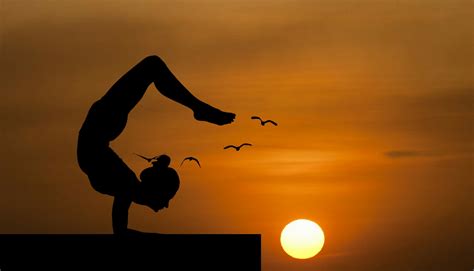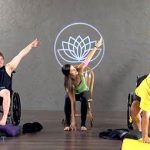Inclusive Yoga for Physical Disabilities: A Comprehensive Guide to Getting Started
Yoga, often associated with flexibility and complex poses, can be adapted to suit the needs of individuals with physical disabilities. This article explores how individuals with various disabilities can benefit from and start their yoga journey in an accessible and customized way. From the historical evolution of adaptive yoga to modern approaches, case studies, and practical guidelines, we will provide a thorough analysis of the topic.
Introduction
Yoga is renowned for its ability to enhance physical and mental well-being. For individuals with physical disabilities, however, traditional yoga practices may seem inaccessible or out of reach. This article seeks to bridge that gap by explaining how yoga can be modified to accommodate diverse physical needs. We will explore the adaptations, benefits, and challenges involved in practicing yoga with physical disabilities, offering practical advice for individuals and professionals looking to create inclusive environments.
Key Concepts
- Adaptive Yoga: A form of yoga that modifies traditional poses and practices to suit individuals with disabilities.
- Chair Yoga: A yoga practice performed while seated or with the assistance of a chair, ideal for those with limited mobility.
- Props and Aids: Equipment such as straps, blocks, and cushions that help modify poses and provide support where needed.
- Mind-Body Connection: Yoga’s emphasis on uniting physical movements with mental awareness, promoting holistic well-being regardless of physical limitations.
Historical Context
Yoga has been practiced for over 5,000 years, but its evolution into a practice accessible to people with disabilities is a relatively recent phenomenon. In the mid-20th century, as yoga gained popularity in the West, pioneers such as B.K.S. Iyengar introduced the use of props to help students of all abilities achieve correct alignment. Later, individuals and organizations began focusing specifically on yoga for people with physical disabilities, leading to the rise of adaptive yoga studios and specialized teacher training programs.
Current State Analysis
Today, adaptive yoga is increasingly recognized as an effective means of promoting physical health, emotional well-being, and community inclusion for individuals with disabilities. Organizations such as Accessible Yoga and Yoga for the Special Child have played a pivotal role in making yoga accessible to all. However, there are still barriers, such as lack of awareness, insufficient teacher training, and limited accessibility in yoga studios.
| Barrier | Solution |
|---|---|
| Lack of Awareness | Promote adaptive yoga through community outreach and partnerships with disability organizations. |
| Insufficient Teacher Training | Expand specialized training programs for yoga instructors to better equip them in working with individuals with disabilities. |
| Limited Accessible Studios | Encourage yoga studios to invest in accessible spaces and props to accommodate a broader range of participants. |
Practical Applications
Yoga can be adapted to accommodate a wide variety of physical disabilities. Below are some practical examples of how individuals with specific disabilities can modify yoga practices to meet their needs:
- Spinal Cord Injury (SCI): Seated poses with the use of props can help engage core muscles, while pranayama (breathing exercises) can promote relaxation and lung capacity improvement.
- Amputation: Adaptive yoga includes the use of props and support from a teacher or partner to balance poses. Chair yoga is another viable option.
- Cerebral Palsy: Yoga for individuals with cerebral palsy often focuses on building flexibility, coordination, and balance through supported poses and mindful breathing.
- Muscular Dystrophy: Gentle, supported movements can help reduce stiffness and increase mobility.
- Multiple Sclerosis (MS): Yoga can be tailored to help with balance issues and muscle weakness, focusing on gentle stretching and relaxation techniques.
Case Studies
Here are a few examples where yoga has been successfully adapted for individuals with disabilities:
| Case | Disability | Outcome |
|---|---|---|
| John’s Journey | Spinal Cord Injury | Through chair yoga and pranayama, John improved his core strength and respiratory function, reducing chronic pain. |
| Sarah’s Success | Amputation | With the help of a trained adaptive yoga instructor, Sarah gained better balance and enhanced her mental well-being. |
| Mike’s Transformation | Cerebral Palsy | Using supported standing poses, Mike developed increased flexibility and motor coordination. |
Stakeholder Analysis
When considering the implementation of yoga programs for individuals with physical disabilities, it’s important to analyze the key stakeholders involved:
- Individuals with Disabilities: The primary beneficiaries of adaptive yoga programs.
- Yoga Instructors: They must receive specialized training in adaptive techniques to meet the needs of all students.
- Healthcare Providers: Doctors and therapists play a critical role in recommending yoga as a complementary therapy for patients with physical disabilities.
- Yoga Studios: Studios need to ensure their spaces and equipment are accessible to individuals with varying physical needs.
- Disability Advocates: Advocacy groups push for greater inclusion and awareness of adaptive yoga practices.
Implementation Guidelines
For yoga instructors and studios interested in offering classes for individuals with disabilities, here are some practical implementation guidelines:
- Invest in accessible spaces with ramps, wide doorways, and adjustable lighting to create a welcoming environment.
- Provide props such as chairs, straps, bolsters, and blocks to support a range of poses.
- Offer individualized modifications during classes to cater to different mobility levels and body types.
- Develop a curriculum that includes both physical poses (asanas) and breathing exercises (pranayama) to enhance overall well-being.
- Partner with healthcare professionals to ensure that the yoga program complements any existing therapy or treatment plans.
Ethical Considerations
Offering yoga to individuals with physical disabilities raises several important ethical considerations:
- Consent and Autonomy: Ensure that participants understand the limitations of their bodies and have the autonomy to refuse poses or movements that are uncomfortable.
- Inclusivity: Yoga instructors must avoid making assumptions about the abilities of individuals based on their disabilities.
- Safety: Prioritize safety by offering modifications that prevent injury and accommodate the individual’s physical limitations.
Limitations and Future Research
While adaptive yoga offers numerous benefits, there are limitations to consider:
- Some disabilities may limit the extent to which individuals can participate in certain yoga practices, particularly in group settings.
- The availability of trained instructors remains limited, which restricts access to adaptive yoga programs in some regions.
- More research is needed to quantify the long-term health benefits of adaptive yoga, particularly for specific conditions such as multiple sclerosis or muscular dystrophy.
Future research could focus on developing standardized protocols for adaptive yoga practices and studying their effects on both physical and mental health outcomes across various disabilities.
Expert Commentary
As an expert in the field, it’s clear that the practice of yoga for individuals with physical disabilities has the potential to transform not only their physical health but also their emotional and mental well-being. The key is to create an inclusive and supportive environment that recognizes the unique needs of each individual. By focusing on accessibility, teacher training, and community awareness, yoga can truly be a practice for everyone.
Mastering Yoga Meditation for Balance: A Holistic Guide for Mind, Body, and Spirit
In a world increasingly filled with distractions, stress, and imbalance, finding peace through yoga meditation has become an essential practice for achieving equilibrium in our physical, mental, and emotional states. This comprehensive guide explores how yoga meditation can restore balance in life, supported by history, practical applications, and expert commentary. We delve into the nuances of achieving harmony through mindful practices, providing actionable insights for everyone—from beginners to seasoned practitioners.
Introduction
Yoga meditation, a blend of ancient traditions and modern mindfulness, offers a holistic approach to restoring balance across different spheres of life. Whether it’s cultivating inner peace, managing stress, or enhancing physical stability, the benefits of these practices are vast. However, balance means different things to different people, and it can be hard to understand how to apply yoga meditation techniques to achieve it. This article will discuss core concepts, provide historical context, and analyze the current state of yoga meditation for balance. We’ll also share case studies, ethical concerns, and limitations to foster a full appreciation of the practice.
Key Concepts
Yoga meditation incorporates a variety of techniques that work in tandem to create mental and physical balance. Key concepts include:
- Pranayama (Breath Control): Controlled breathing techniques to manage energy and focus.
- Asana (Postures): Physical poses designed to enhance flexibility, strength, and balance.
- Dhyana (Meditation): Focused meditation to cultivate mindfulness and mental clarity.
- Samatva (Equanimity): The principle of maintaining mental balance, unaffected by external circumstances.
Historical Context
Yoga meditation dates back thousands of years, with its origins in ancient Indian philosophy. The concept of balance has always been central to yogic teachings. In early texts like the Bhagavad Gita and the Yoga Sutras, balance was not only a physical concept but a spiritual one—requiring harmony between body, mind, and soul.
| Period | Key Development | Impact on Balance Practices |
|---|---|---|
| 500 BCE | Development of early yoga texts (Upanishads, Bhagavad Gita) | Focus on spiritual and mental balance through meditation and detachment |
| 200 CE | Compilation of the Yoga Sutras by Patanjali | Structured the balance between physical, mental, and ethical practices |
| Modern Era | Introduction of yoga to the West (19th-20th century) | Emphasis on physical balance (asana) in popular culture |
Current State Analysis
Today, yoga meditation for balance is practiced worldwide, and it has been integrated into various settings, from yoga studios to corporate wellness programs. However, with its widespread adoption come challenges:
- Overemphasis on Physical Aspects: Many Western yoga practices prioritize asana (postures) over the mental and spiritual aspects, reducing the holistic potential of yoga meditation.
- Commercialization: Yoga’s commercialization has led to a loss of focus on authentic practices aimed at inner balance and mindfulness.
- Scientific Backing: The growing body of research supports yoga meditation’s role in reducing stress, improving mental health, and enhancing physical stability.
Practical Applications
To achieve balance through yoga meditation, it is essential to incorporate practical steps that align mind, body, and spirit:
- Set an Intention: Whether you’re aiming for emotional balance or physical stability, setting a clear intention helps guide the practice.
- Engage in Breathwork: Incorporating pranayama exercises like Nadi Shodhana (alternate nostril breathing) can quickly center the mind.
- Focus on Stability Poses: Balance postures such as Tree Pose (Vrksasana) and Warrior III (Virabhadrasana III) improve focus and physical equilibrium.
- Practice Mindful Meditation: Spend at least 10 minutes daily in seated meditation to cultivate mental clarity and emotional stability.
- Consistent Practice: Balance is not achieved overnight; a consistent and disciplined approach yields the best results.
Case Studies
Several case studies illustrate the profound impact of yoga meditation on achieving balance in life:
| Case Study | Context | Outcome |
|---|---|---|
| Corporate Wellness Program | Implemented yoga meditation sessions for employees to reduce stress and improve focus. | After six months, employees reported a 40% reduction in workplace stress and a 25% increase in productivity. |
| Rehabilitation Program for Veterans | Veterans struggling with PTSD were introduced to yoga meditation as part of their treatment plan. | Participants experienced a significant decrease in anxiety and improved emotional balance. |
| Yoga Therapy for Chronic Pain Patients | Patients dealing with chronic pain integrated yoga meditation to improve mental resilience and reduce pain perception. | Over a year, patients showed a 30% decrease in reported pain levels and enhanced mental balance. |
Stakeholder Analysis
Understanding the perspectives of various stakeholders is crucial for a balanced application of yoga meditation:
- Practitioners: Seek mental, physical, and emotional balance, often using yoga meditation as a tool for stress management and well-being.
- Yoga Instructors: Must balance teaching physical postures with imparting the deeper philosophical teachings of yoga.
- Healthcare Providers: Increasingly recommend yoga meditation for holistic treatments, focusing on mental health and physical therapy.
- Businesses: Implement yoga meditation programs to boost employee well-being and productivity.
Implementation Guidelines
For those seeking to introduce yoga meditation for balance into their lives or organizations, the following steps can guide implementation:
- Define Objectives: Establish clear goals for incorporating yoga meditation, such as reducing stress or improving physical balance.
- Tailor the Approach: Adapt practices to the needs of the group or individual, ensuring a balance between physical and mental exercises.
- Monitor Progress: Use regular assessments, like surveys or physical tests, to track the progress of balance improvement.
- Ensure Consistency: Encourage a consistent practice schedule for long-term benefits.
- Offer Resources: Provide materials like guided meditations, apps, and access to expert instructors.
Ethical Considerations
With yoga meditation’s popularity comes ethical considerations:
- Cultural Appropriation: Yoga is a practice with deep cultural roots in India, and its commercialization can sometimes strip it of its cultural significance. Care must be taken to respect its origins.
- Inclusivity: Yoga meditation should be accessible to all, regardless of physical ability, cultural background, or financial status.
- Instructor Certification: Ensure that instructors are properly trained and certified to avoid harm and misinformation.
Limitations and Future Research
Despite its benefits, yoga meditation is not a cure-all, and certain limitations must be acknowledged:
- Physical Limitations: Not all postures are accessible to everyone, particularly those with physical disabilities or injuries.
- Overemphasis on Asana: Focusing solely on physical postures can neglect the mental and spiritual aspects of yoga meditation.
- Need for More Research: While research supports the benefits of yoga meditation for balance, more longitudinal studies are required to understand its long-term effects on mental and physical health.
Future research should explore the integration of yoga meditation with emerging technologies, such as virtual reality, to make these practices more accessible and customizable for individuals with varying needs.
Expert Commentary
Yoga meditation has proven to be a highly effective practice for achieving both physical and mental balance. However, as experts continue to investigate its long-term benefits, it is important to approach it with a holistic mindset that values not only the physical but also the mental, emotional, and spiritual dimensions of well-being. Balance is not a destination but an ongoing process, and yoga meditation offers the tools to navigate this journey with grace and mindfulness.








